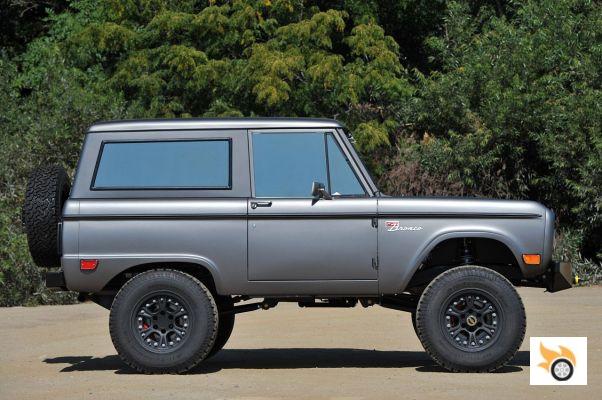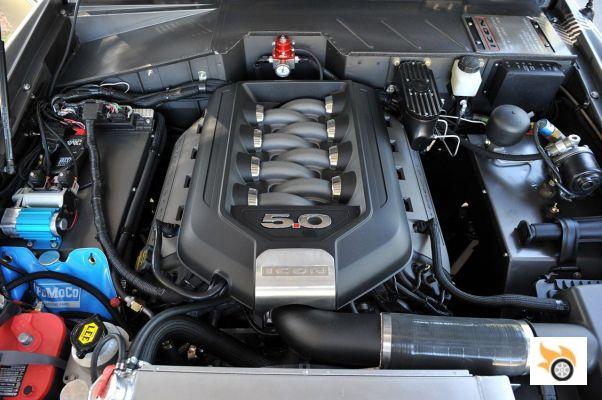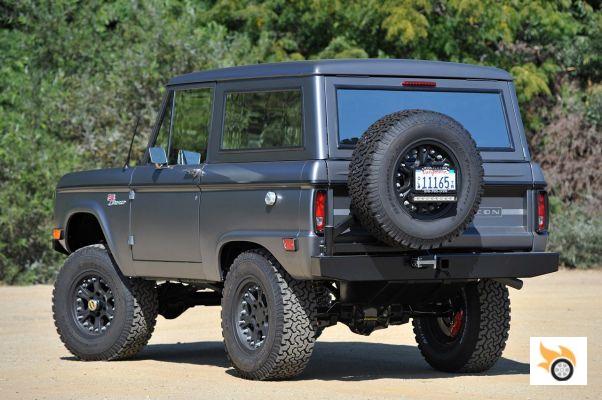Let's say, to create the best possible unit without going out of the proposed script, a bit in the same line of Singer and his work with Porsche. We love this kind of projects, and they always result in interesting products, with not so interesting invoices.
A few months ago, our colleague from the North American edition, Drew Phillips, had the opportunity to ride for a few hours in this interesting ICON Bronco, and of course, after falling in love with this SUV, based on the Ford's namesake from the seventies and eighties, we could not miss the opportunity to bring you here his impressions, conveniently adapted, as always.

"The watch industry is a good parallel, since none of us need watches anymore," Jonathon Ward, founder of ICON 4×4, offers a metaphor for his latest project. "The secret to them thriving and continuing to function in the modern marketplace is all about execution, making the manufacturing something different, handcrafted, by design. We're trying to do something similar, remove the unnecessary ethics of other industries and evolve in the automotive niche."
In other words, Ward knows that the custom creations he makes are superfluous, but like expensive watches, people appreciate them beyond their practical use. We fall into that group, appreciating his cars more as a whole than as the sum of their parts.
The company's latest project is the ICON Bronco. After completing the development of the FJ series (their first complete project), Ward has turned his unique eye to Ford's legendary off-roader from the 1960s and '70s. ICON officially debuted it last year at SEMA in Las Vegas, and Ward then gave us the opportunity to have a brief hands-on with it around the streets of the California town where he's based, Van Nuys.
Ironically, the start of the ICON Bronco project began with Ward's contact with Toyota. Jim Farley, Ford's current head of worldwide marketing, was first working at Toyota and Scion, where Ward was working with him as a consultant on the FJ Cruiser. After Farley left for Ford, he spoke to Ward again to see if he would be interested in doing a one-off Bronco, using one of the new reproduction bodies made by Dynacorn. Ward was motivated by the idea, but had a slightly more ambitious vision for the project. "I came home and thought about the opportunity, realizing that the Bronco was the most in-demand car as the next project for ICON," he said. "We thought if we did it, it didn't have to be a one-off, but we wanted to put in the engineering time to create a new platform and turn it into a production model."
Before Farley proposed the project, Ward already had the Bronco in his head. He had bought a unit, and had driven it for a few months to see if the platform was valid and viable for an Icon model. "I drove it long enough to realize that there were tons of opportunities to evolve the chassis, the powertrain, the ergonomics, the air conditioning, the heating, all that stuff," he said. "I drove it enough to realize that I didn't have enough patience for the classic character of the platform of the car, but I always loved the aesthetics of it. So when this whole thing got going I was very clear on the things to do."
While he knew he wanted to do the Bronco, Ward also knew he had to approach the project differently than with previous creations like the FJ or CJ. "Instead of me putting seven figures into investing in research and development myself, this time I tried to look first and foremost to find loyal customers for my brand." Ward sent out a message to some of his customers and fans, to see if he could find five people interested in buying a Bronco he'd modified. Four hours later he had a response. The first five Broncos had owners, and Ward had money for the car's development. "This gave us a clear signal that we were on the right track," he says.
Another difference between the Bronco and previous projects is that Ward hired a designer. Ward himself did the design for the FJ and CJ, but for the Bronco he hired Camilo Pardo. The former Ford designer is probably best known for his best work: the Ford GT no less, but he has also worked designing fashion, furniture, art... Ward says that they formed an ideal couple "his designs and mine combine perfectly".
While the original plan was to use brand new Dynacorn bodies, the first group of units is based on original models from 1966 to 1977. "Potentially, we will move production to use Dynacorn bodies, but for the time being we prefer to use original bodies until the others are proven in the market and their quality is beyond doubt," says Ward, although finding a body in good condition is no easy task. "We scoured the country and bought ten of the best condition units we could find, all with original paint, known history and no modifications, so we have the best blank canvases you can have."
Even with Ford's blessing and some enthusiastic customers, the ICON Bronco might have remained unborn, at least as we know it now, without the help of a somewhat strange collaborator: Nike. But what's a sneaker brand doing involved in this? According to Ward, what happened came thanks to a meeting with Nike's CEO, talking about how to combine past and present, something Nike does as well, according to the brand itself.
Nike's appreciation for ICON's approach was essential to the development of the Bronco, as it gave them access to rapid prototyping and manufacturing machines that would otherwise have been unavailable to them. It all started with Nike designers tinkering with some of the Bronco's most basic design elements, but soon evolved into a team of ten mathematicians, programmers, and millers joining these initial designers. As Ward and Pardo worked on their designs for each part, the Nike team produced rapid prototypes in stereolithography to validate each design. Ward says that without this help it would have been impossible to explore so many possible designs and so much love for the smallest detail.
In what aspects of the Bronco has this system of working been applied? If you take Ward's point of view, virtually every single part. Take the front grille, for example, which is constructed from a single piece of B4 stainless steel, laser-cut and welded with TIC technology. Each of the ICON letters that adorn it are CNC machined from stainless steel and painted one by one. Nothing is made of plastic and not a single part is a standard component, from the door handles to the mirrors to the turn signals. Every part has been CAD recreated, CNC machined or laser cut from stainless steel plate. Nothing looks out of place, if anything. Ward initially considered including integrated turn signals in the mirrors, but quickly realized they would look too modern and out of place.
The attention to detail continues inside the cabin, and Ward's love of industrial design comes through here too. Aluminum panels are found on the dash and doors, like a luxury skyscraper elevator door. The sun visors are identical to those of a Learjet aircraft. The seats are made of the same material as those in the Los Angeles Museum of Modern Art. Each of the switches is machined from solid stainless steel. But if we had to choose one piece of the interior, it's the clock box, inspired by a Bell & Ross clock, and designed by Ward and Pardo, using Dakota Digital VHX hands as a base. Ward is also proud that almost all of the components are "made in the USA", with the notable exception of the leather seats, sourced from Mercedes-Benz, no less.
While all the details are appealing to the eye, don't make the mistake of thinking it's all looks and the car doesn't know how to move. As with the FJ and CJ, Ward negotiated with Art Morrison to have a custom-tuned chassis made from chrome-moly steel, bent and supported by Eibach springs damped by Fox Racing kits, with 12 inches of travel on both axles. Power is transferred through custom-made Atlas II axles and transfer case, the axles being solid Dana 60s and 44s.
And speaking of power, under the front hood of the ICON Bronco we find a Ford Coyote 5.0 V8 already seen in the F-150 and Mustang GT, with few changes (including a specific exhaust manifold). It offers 412 hp and 530 Nm of peak torque, although if the customer wants more, Ward will give it to him.

Before we got behind the wheel of the Bronco, Ward wanted us to drive an unmodified vintage Bronco first so we could appreciate the differences. Needless to say, after a few minutes behind the old Bronco, we accepted Ward's premise that using such a classic can be frustrating. The feel of the controls (steering wheel, steering, throttle, clutch) were nil, and we missed gears unintentionally. We also stalled the car, and then it didn't want to start again after the battery failed. Things of the classics.
We then rode in the ICON Bronco with the idea of looking for similarities, but it's a completely different experience. Ward has made a huge effort to modernize the components without changing the aesthetics, and that now has climate control, keyless entry and start, adjustable steering wheel in height and depth, more soundproofing ....
The V8 starts with a button on the steering wheel. We are glad to see a gearshift mounted on the floor, and not behind the rim of the steering wheel. We put it in first gear and give it some gas to get moving. We'd be lying if we told you that the Bronco handles particularly well (it still retains a good degree of body roll) but the improvement over the original is astronomical. We'd simply say there's no other "retro" SUV that handles this well. Wards tells us that there's still some fine tuning to be done, especially with the stabilizers, which should reduce body roll.
Put the pedal to the metal and the five-litre comes alive, giving us a good kick and a deep exhaust note through the single rear tailpipe. Again Ward tells us that there are improvements to be made to the exhaust system, as he wants something fatter.
As we head back to the car park we ask the inevitable question: how much for one of these? We know what's coming next, but we still shudder a little at the answer. Aside from the "donor vehicle", the Bronco goes for $150,000, about $120,000, and to that we have to add the nearly $15,000 that a good condition donor unit can cost.

And the bill only starts there, because there are a thousand and one options to make the price soar up to $200,000 easily. One of Ward's favorites is "skyscraper-style" glass, which is tempered with a reflective coating on the outside and a smoked tint on the inside, taking the term "tinted glass" a step further. You can also count on 14-inch brakes from Stoptech, which we'd highly recommend given the V8's potential, as well as locking differentials and a sport suspension system with separate gas tanks.
You can also order a removable roof instead of a sheet metal one. Colours? Ward says you can order just about any color you can think of, though he's sticking with matte tones.
At the end of the day, you're either in love with the Bronco, or you hate it. Home restorers will tell you that they can make one just like it for a lot less money. But the reality is that ICON's level of detail is much more than that. It's a work of industrial design art, with a completely new custom chassis, and a unique level of finish and ride feel that also allows it to be used on a day-to-day basis. "Low volume, high design level products, usable every day, no sacrifices," is what Ward says, and that's something to be thankful for in a time when we've become accustomed to manufacturers obsessed with economies of scale and platforms. The world could get used to and fall in love with products like the ICON Bronco, the problem is in the price?
Article originally published in August 2013, recovered for Pistonudos.
























